Modelling the Impacts of Climate Change on Shallow Groundwater Conditions in Hungary
Abstract
:1. Introduction
- Surface runoff;
- Evapotranspiration;
- Groundwater recharge;
- Soil water content;
- Surface water levels and quality;
- Groundwater levels and quality;
- Snow and ice cover.
2. Goals
3. Test Site
4. Materials and Methods
4.1. Applied Methodology
- Climate zones were determined based on measured and simulated climate variables.
- Recharge zones were delineated based on slope, landuse, and surface geology.
- Recharge was calculated for recharge zones making use of 1D analytical hydrological models.
- Groundwater table distribution was simulated by using numerical groundwater models.
- It is quantitative and physics-based;
- Each step of the workflow is replicable and provides coherent results for various climate conditions;
- Modular workflow offers flexibility: input data and resolution. Furthermore, calculation tools can be replaced or changed at various levels.
- 1961–1965;
- 2005–2009;
- 1961–1990;
- 2021–2050;
- 2071–2100.
4.2. Climate Data
4.3. Climate Classification
4.4. Recharge Zones
4.5. Hydrological Modelling
4.6. Groundwater Modelling
Calibration Methodology
5. Results
6. Discussion
7. Conclusions
- Climate zones were determined based on measured and simulated climate variables;
- Recharge zones were delineated based on slope, landuse and surface geology;
- Recharge was calculated for recharge zones making use of 1D analytical hydrological models;
- Groundwater table distribution was simulated using numerical groundwater models.
Author Contributions
Funding
Institutional Review Board Statement
Informed Consent Statement
Data Availability Statement
Conflicts of Interest
Disclaimer
References
- UNESCO. Groundwater Resources Assessment under the Pressures of Humanity and Climate Change (GRAPHIC): A Framework Document; GRAPHIC Series Number 2; United Nations Educational, Scientific, and Cultural Organization (UNESCO): Paris, France, 2008; p. 31. [Google Scholar]
- Hengeveld, H.G. Projections for Canada’s Climate Future. A Discussion of Recent Simulations with CGCM. Atmospheric and Climate Science Directorate, Science Assessment and Integration Branch; Meteorological Service Canada: Downsview, ON, Canada, 2000; 32p. [Google Scholar]
- Mearns, L.O.; Hulme, M.; Carter, T.R.; Leemans, R.; Lal, M.; Whetton, P. Climate scenario development. In Climate Change 2007: The Physical Science Basis. Contribution of Working Group I to the Fourth Assessment Report of the Intergovernmental Panel on Climate Change; Solomon, S., Qin, D., Manning, M., Chen, Z., Marquis, M., Averyt, K.B., Tignor, M., Miller, H.L., Eds.; Cambridge University Press: Cambridge, UK; New York, NY, USA, 2007; pp. 739–768. [Google Scholar]
- Le Treut, H.; Somerville, R.; Cubasch, U.; Ding, Y.; Mauritzen, C.; Mokssit, A.; Peterson, T.; Prather, M. Historical Overview of Climate Change. In Climate Change 2007: The Physical Science Basis. Contribution of Working Group I to the Fourth Assessment Report of the Intergovernmental Panel on Climate Change; Solomon, S.D.Q., Manning, M., Chen, Z., Marquis, M., Averyt, K.B., Tignor, M., Miller, H.L., Eds.; Cambridge University Press: Cambridge, UK; New York, NY, USA, 2007. [Google Scholar]
- Van Dijck, S.J.E.; Laouina, A.; Carvalho, A.V.; Loos, S.; Schipper, A.M.; Van der Kwast, H.; Nafaa, R.; Antari, M.; Rocha, A.; Borrego, C.; et al. Desertification in northern Morocco due to effects of climate change on groundwater recharge. In Desertification in the Mediterranean Region: A Security Issue; Kepner, W.G., Rubio, J.L., Mouat, D.A., Pedrazzini, F., Eds.; Springer: Dordrecht, The Netherlands, 2006; pp. 549–577. [Google Scholar]
- Woldeamlak, S.T.; Batelaan, O.; De Smedt, F. Effects of climate change on the groundwater system in the Grote-Nete catchment, Belgium. Hydrogeol. J. 2007, 15, 891–901. [Google Scholar] [CrossRef]
- Chiew, F.H.S.; McMahon, T.A. Modelling the impacts of climate change on Australian streamflow. Hydrol. Process. 2002, 16, 1235–1245. [Google Scholar] [CrossRef]
- Cayan, D.R.; Kammerdiener, S.A.; Dettinger, M.D.; Caprio, J.M.; Peterson, D.H. Changes in the onset of spring in the western United States. Bull. Am. Meteorol. Soc. 2001, 82, 399–415. [Google Scholar] [CrossRef] [Green Version]
- Stewart, I.T.; Cayan, D.R.; Dettinger, M.D. Changes in snowmelt runoff timing in western North America under a ‘business as usual’ climate change scenario. Clim. Change 2004, 62, 217–232. [Google Scholar] [CrossRef]
- Mote, P.W.; Hamlet, A.F.; Clark, M.P.; Lettenmaier, D.P. Declining mountain snowpack in western North America. Am. Meteorol. Soc. 2005, 86, 39–49. [Google Scholar] [CrossRef]
- Tague, C.; Grant, G.; Farrell, M.; Choate, J.; Jefferson, A. Deep groundwater mediates streamflow response to climate warming in the Oregon Cascades. Clim. Change 2008, 86, 189–210. [Google Scholar] [CrossRef]
- Barnett, T.P.; Pierce, D.W.; Hidalgo, H.G.; Bonfils, C.; Santer, B.D.; Das, T.; Bala, G.; Wood, A.W.; Nozawa, T.; Mirin, A.A.; et al. Human-induced changes in the hydrology of western United States. Science 2008, 319, 1080–1083. [Google Scholar] [CrossRef] [Green Version]
- Moberg, A.; Jones, P.D. Trends in indices for extremes in daily temperature and precipitation in central and western Europe, 1901–1999. Int. J. Climatol. 2005, 25, 1149–1171. [Google Scholar] [CrossRef]
- Spinoni, J.; Lakatos, M.; Szentimrey, T.; Bihari, Z.; Szalai, S.; Vogt, J.; Antofie, T. Heat and cold waves trends in the Carpathian Region from 1961 to 2010. Int. J. Climatol. 2015, 35, 4197–4209. [Google Scholar] [CrossRef] [Green Version]
- Illy, T.; Sábitz, J.; Szabó, P.; Szépszó, G.; Zsebeházi, G. A Klímamodellekből Levezethető Indikátorok Alkalmazási Lehetőségei; Országos Meteorológiai Szolgálat: Budapest, Hungary, 2015; 104p. [Google Scholar]
- Szentimrey, T.; Bihari, Z.T.; Lakatos, M.; Kovács, T.; Németh, Á.; Szalai, S.; Hiebl, J.; Auer, I.; Milkovid, J.; Zahradníček, P.; et al. Final Version of Gridded Datasets of All Harmonized and Spatially Interpolated Meteorological Parameters, per Country. Contract Number: OJEU 2010/S 110-166082. 2012. Available online: http://www.CARPATCLIM-eu.org/pages/deliverables.
- Thornthwaite, C.W. An approach toward a rational classification of climate. Geogr. Rev. 1948, XXXVIII, 55–93. [Google Scholar] [CrossRef]
- Schroeder, P.R.; Aziz, N.M.; Zappi, P.A. The Hydrologic Evaluation of Landfill Performance (HELP) Model: User’s Guide Version 3, EPA/600/R-94/168a; U.S Environmental Protection Agency Office of Research and Development: Washington, DC, USA, 1994.
- Gogolev, M.I. Assessing groundwater recharge with two unsaturated zone modeling technologies. Environ. Geol. 2002, 42, 248–258. [Google Scholar] [CrossRef]
- Kovács, A.; Marton, A.; Tóth, G.; Szőcs, T. A sekély felszín alatti vizek klímaérzékenységének országos léptékű vizsgálata. Hidrológiai Közlöny 2016, 9, 21–32. [Google Scholar]
- Lakatos, M.; Szentimrey, T.; Bihari, Z.; Szalai, S. Creation of a homogenized cli-mate database for the Carpathian region by applying the MASH procedure and the preliminary analysis of the data. Időjárás 2013, 117, 143–158. [Google Scholar]
- Szentimrey, T. Development of MASH homogenization procedure for daily data. In Proceedings of the Fifth Seminar for Homogenization and Quality Control in Climatological Databases, Budapest, Hungary, 29 May–2 June 2006; WCDMP-No. 71, WMO/TD-NO. 1493. pp. 123–130. [Google Scholar]
- Szentimrey, T.; Bihari, Z. Mathematical background of the spatial interpolation methods and the software MISH (Meteorological Interpolation based on Surface Homogenized Data Basis). In Proceedings of the Conference on Spatial Interpolation in Climatology and Meteorology; Szalai, Z.S., Bihari, T., Szentimrey, M., Lakatos, M., Eds.; COST Office: Luxemburg, 2007; pp. 17–28. ISBN 92-898-0033-X. [Google Scholar]
- Szalai, S.; Auer, I.; Hiebl, J.; Milkovich, J.; Radim, T.; Stepanek, P.; Zahradnicek, P.; Bihari, Z.; Lakatos, M.; Szentimrey, T.; et al. Climate of the Greater Carpathian Region; Final Technical Report; Carpatclim Consortium. 2013. Available online: www.carpatclim-eu.org.
- European Commission. Joint Research Centre, Carpatclim Database of the Carpathian Region; European Commission: Brussels, Belgium, 2013; Available online: http://www.carpatclim-eu.org.
- Hewitt, C.D.; Griggs, D.J. Ensembles based predictions of climate changes and their impacts. Eos Trans. AGU 2004, 85, 566. [Google Scholar] [CrossRef]
- Horányi, A.; Kertész, S.; Kullmann, L.; Radnóti, G. The ARPEGE/ALADIN mesoscale numerical modeling system and its application at the Hungarian Meteorological Service. Időjárás 2006, 110, 203–227. [Google Scholar]
- Bubnová, R.; Hello, G.; Bénard, P.; Geleyn, J.-F. Integration of the fully elastic equations cast in the hydrostatic pressure terrain-following coordinate in the framework of ARPEGE/Aladin NWP system. Mon. Weather Rev. 1995, 123, 515–535. [Google Scholar] [CrossRef] [Green Version]
- Météo-France Centre National de Recherches Météorologiques. ARPÉGE-Climate Version 5.1 Algorithmic Documentation; Météo-France: Paris, France, 2008. [Google Scholar]
- Farda, A.; Déqué, M.; Somot, S.; Horányi, A.; Spiridonov, V.; Tóth, H. Model ALADIN as regional climate model for central and eastern Europe. Studia Geophys. Geod. 2010, 54, 313–332. [Google Scholar] [CrossRef]
- National Adaptation Geo-information System of Hungary (NAGis). 2015. Available online: https://nater.mbfsz.gov.hu.
- Nakicenovic, N.; Swart, R. Special Report on Emissions Scenarios. A Special Report of Working Group III of the Intergovernmental Panel on Climate Change; Cambridge University Press: Cambridge, UK; New York, NY, USA, 2000. [Google Scholar]
- van Vuuren, D.P.; Carter, T.R. Climate and socio-economic scenarios for climate change research and assessment: Reconciling the new with the old. Climatic Change 2014, 122, 415–429. [Google Scholar] [CrossRef] [Green Version]
- Köppen, W. Das geographische System der Klimata. In Handbuch der Klimatologie; Köppen, W., Geiger, R., Eds.; Gebrüder Borntraeger: Berlin, Germany, 1936; 44p. [Google Scholar]
- Holdridge, L.R. Determination of world plant formations from simple climatic data. Science 1947, 105, 367–368. [Google Scholar] [CrossRef]
- Szelepcsényi, Z.; Breuer, H.; Ács, F.; Kozma, I. Biofizikai klímaklasszifikációk. 2. rész: Magyarországi alkalmazások. Légkör 2009, 54, 18–24. [Google Scholar]
- Ács, F.; Breuer, H. Biofizikai Éghajlat-Osztályozási Módszerek; ELTE University: Budapest, Hungary, 2012; 244p. [Google Scholar]
- Neitsch, S.L.; Arnold, J.G.; Kiniry, J.R.; Srinivasan, R.; Williams, J.R. Soil & Water Assessment Tool; Grassland, Soil & Water Research Laboratory: Temple, TX, USA, 2002.
- Gyalog, L.; Síkhegyi, F. (Eds.) Geological Map of Hungary, 1:100,000; Geological and Geophysical Institute of Hungary: Budapest, Hungary, 2005. [Google Scholar]
- European Environment Agency. Corine Land Cover Raster Data. 2006. Available online: http://www.eea.europa.eu/data-and-maps/data/corine-land-cover-2006-raster.
- John Doherty, PEST Model-Independent Parameter Estimation. In User Manual, 5th ed.; Watermark Numerical Computing: Brisbane, Australia, 2004.
- Green, T.R.; Taniguchi, M.; Kooi, H.; Gurdak, J.J.; Allen, D.M.; Hiscock, K.M.; Treidel, H.; Aureli, A. Beneath the surface of global change: Impacts of climate change on groundwater. J. Hydrol. 2011, 405, 532–560. [Google Scholar] [CrossRef] [Green Version]
- Loaiciga, H.A.; Maidment, D.R.; Valdes, J.B. Climate-change impacts in a regional karst aquifer, Texas, USA. J. Hydrol. 2000, 227, 173–194. [Google Scholar] [CrossRef]
- Allen, D.M.; Mackie, D.C.; Wei, M. Groundwater and climate change: A sensitivity analysis for the grand forks aquifer, southern British Columbia, Canada. Hydrogeol. J. 2004, 12, 270–290. [Google Scholar] [CrossRef]
- Brouyere, S.; Carabin, G.; Dassargues, A. Climate change impacts on groundwater resources: Modelled deficits in a chalky aquifer, Geer Basin, Belgium. Hydrogeol. J. 2004, 12, 123–134. [Google Scholar] [CrossRef] [Green Version]
- Vaccaro, J.J. Sensitivity of groundwater recharge estimates to climate variability and change, Columbia Plateau, Washington. J. Geophys. Res. 1992, 97, 2821–2833. [Google Scholar] [CrossRef]
- Scibek, J.; Allen, D.M.; Cannon, A.J.; Whitfield, P.H. Groundwater–surface water interaction under scenarios of climate change using a high-resolution transient groundwater model. J. Hydrol. 2007, 333, 165–181. [Google Scholar] [CrossRef]
- Jyrkama, M.I.; Sykes, J.F. The impact of climate change on spatially varying groundwater recharge in the grand river watershed (Ontario). J. Hydrol. 2007, 338, 237–250. [Google Scholar] [CrossRef]
- Serrat-Capdevila, A.; Valdes, J.B.; Perez, J.G.; Baird, K.; Mata, L.J.; MaddockIii, T. Modeling climate change impacts—And uncertainty—On the hydrology of a riparian system: The San Pedro Basin (Arizona/Sonora). J. Hydrol. 2007, 347, 48–66. [Google Scholar] [CrossRef]
- Toews, M.W.; Allen, D.M. Evaluating different GCMs for predicting spatial recharge in an irrigated arid region. J. Hydrol. 2009, 374, 265–281. [Google Scholar] [CrossRef]
- van Roosmalen, L.; Christensen, B.S.B.; Sonnenborg, T.O. Regional differences in climate change impacts on groundwater and stream discharge in Denmark. Vadose Zone J. 2007, 6, 554–571. [Google Scholar] [CrossRef]
- van Roosmalen, L.; Sonnenborg, T.O.; Jensen, K.H. Impact of climate and land use change on the hydrology of a large-scale agricultural catchment. Water Resour. Res. 2009, 45, W00A15. [Google Scholar] [CrossRef] [Green Version]
- Rosenberg, N.J.; Epstein, D.J.; Wang, D.; Vail, L.; Srinivasan, R.; Arnold, J.G. Possible impacts of global warming on the hydrology of the Ogallala Aquifer region. Clim. Change 1999, 42, 677–692. [Google Scholar] [CrossRef]
- York, J.P.; Person, M.; Gutowski, W.J.; Winter, T.C. Putting aquifers intoatmospheric simulation models: An example from the Mill Creek Watershed, northeastern Kansas. Adv. Water Resour. 2002, 25, 221–238. [Google Scholar] [CrossRef] [Green Version]
- Yu, Z.; Pollard, D.; Cheng, L. On continental-scale hydrologic simulations with a coupled hydrologic model. J. Hydrol. 2006, 331, 110–124. [Google Scholar] [CrossRef]
- Mileham, L.; Taylor, R.; Thompson, J.; Todd, M.; Tindimugaya, C. Impact ofrainfall distribution on the parameterisation of a soil-moisture balance model of groundwater recharge in equatorial Africa. J. Hydrol. 2008, 359, 46–58. [Google Scholar] [CrossRef]
- Mileham, L.; Taylor, R.G.; Todd, M.; Tindimugaya, C.; Thompson, J. The impact of climate change on groundwater recharge and runoff in a humid, equatorial catchment: Sensitivity of projections to rainfall intensity. Hydrol. Sci. J. 2009, 54, 727–738. [Google Scholar] [CrossRef] [Green Version]
- Rivard, C.; Paniconi, C.; Gauthier, M.J.; François, G.; Sulis, M.; Camporese, M.; Larocque, M.; Chaumont, D. A modeling study of climate change impacts on recharge and surface–groundwater interactions for the Thomas brook catchment (Annapolis Valley, Nova Scotia). In Proceedings of the GeoEdmonton, Canadian Geotechnical Society—International Association of Hydrogeologists—Canadian National Chapter Joint Annual Conference, Edmonton, AB, Canada, 21–24 September 2008. [Google Scholar]
- Tietjen, B.; Zehe, E.; Jeltsch, F. Simulating plant water availability in dry lands under climate change: A generic model of two soil layers. Water Resour. Res. 2009, 45, W01418. [Google Scholar] [CrossRef]
- Kidmose, J.; Refsgaard, J.C.; Troldborg, L.; Seaby, L.P.; Escriv, M.M. Climate change impact on groundwater levels: Ensemble modelling of extreme values. Hydrol. Earth Syst. Sci. 2013, 17, 1619–1634. [Google Scholar] [CrossRef] [Green Version]
- Raposo, J.R.; Dafonte, J.; Molinero, J. Assessing the impact of future climate change on groundwater recharge in Galicia-Costa, Spain. Hydrogeol. J. 2013, 21, 459–479. [Google Scholar] [CrossRef]
- Mollema, P.N.; Antonellini, M. Seasonal variation in natural recharge of coastal aquifers. Hydrogeol. J. 2013, 21, 787–797. [Google Scholar] [CrossRef]
- Kumar, C.P. AssessIng the impact of clImate change on groundwater resources. IWRA (India) J. 2016, 5, 3–11. [Google Scholar]
- Simonffy, Z. CC-WaterS—Climate Change and Impacts on Water Supply. WP4: Availability of Water Resources. Final Report. 2012. Available online: http://www.southeast-europe.net/en/achievements/outputs_library/?id=65.
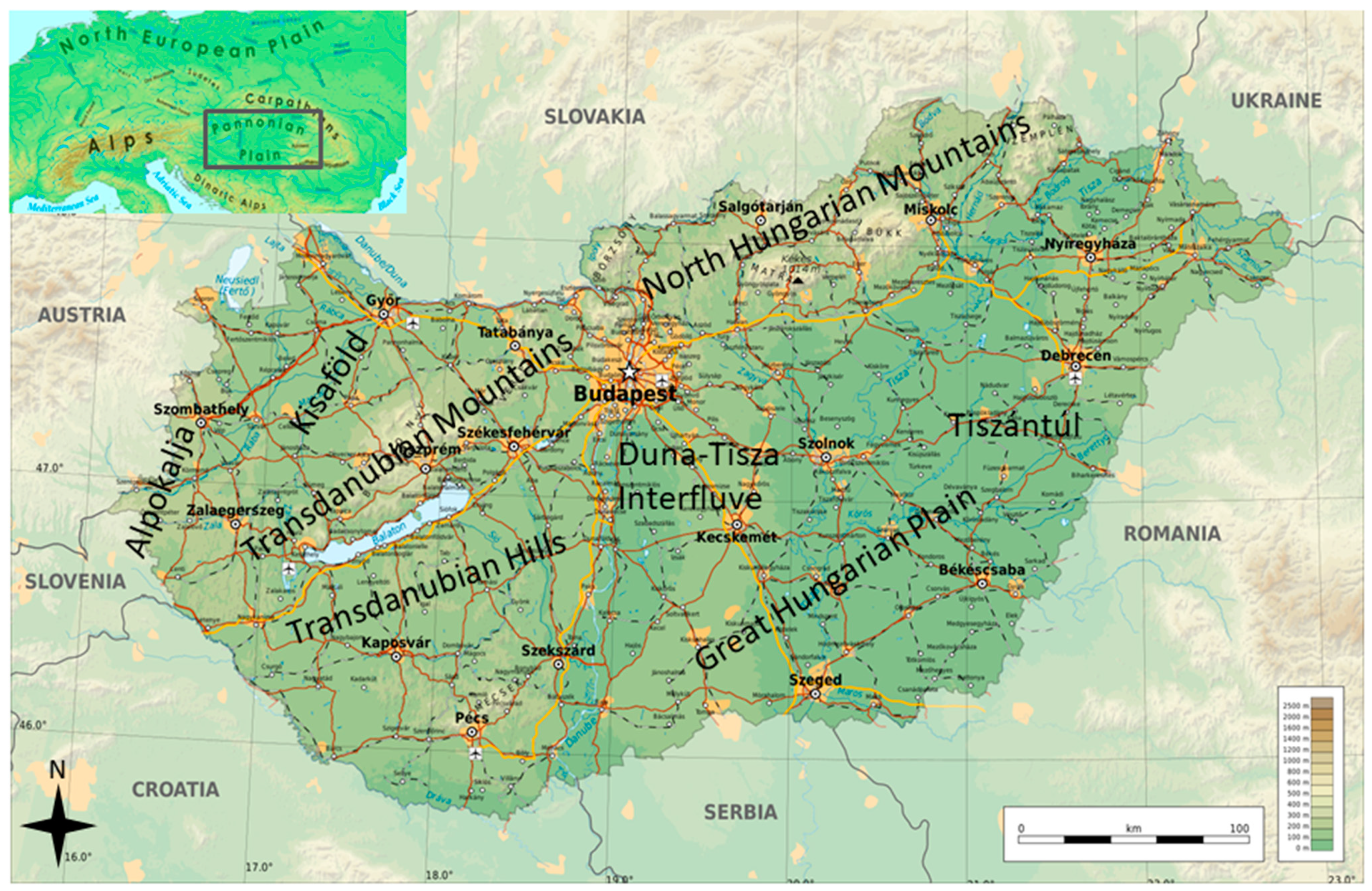

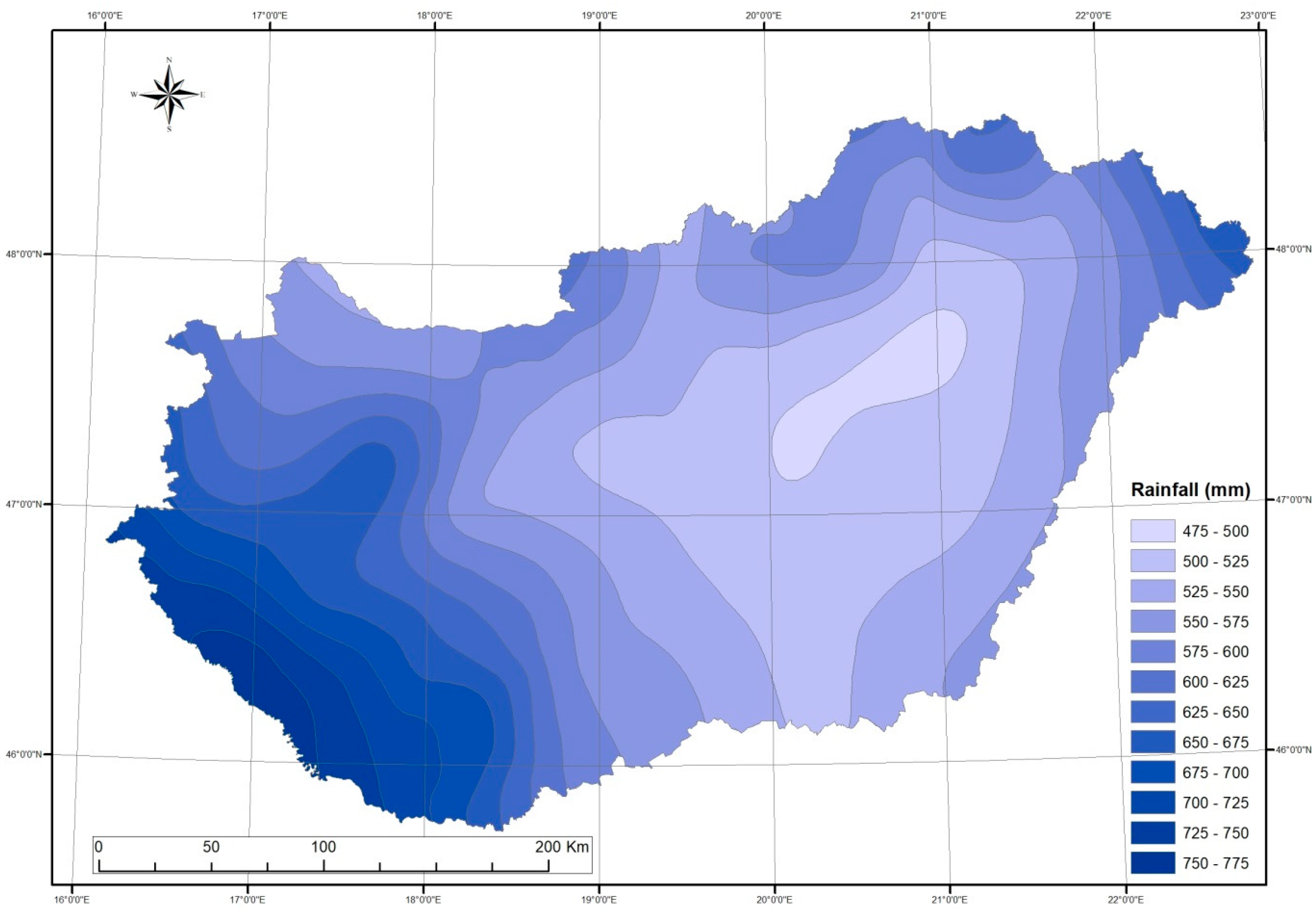
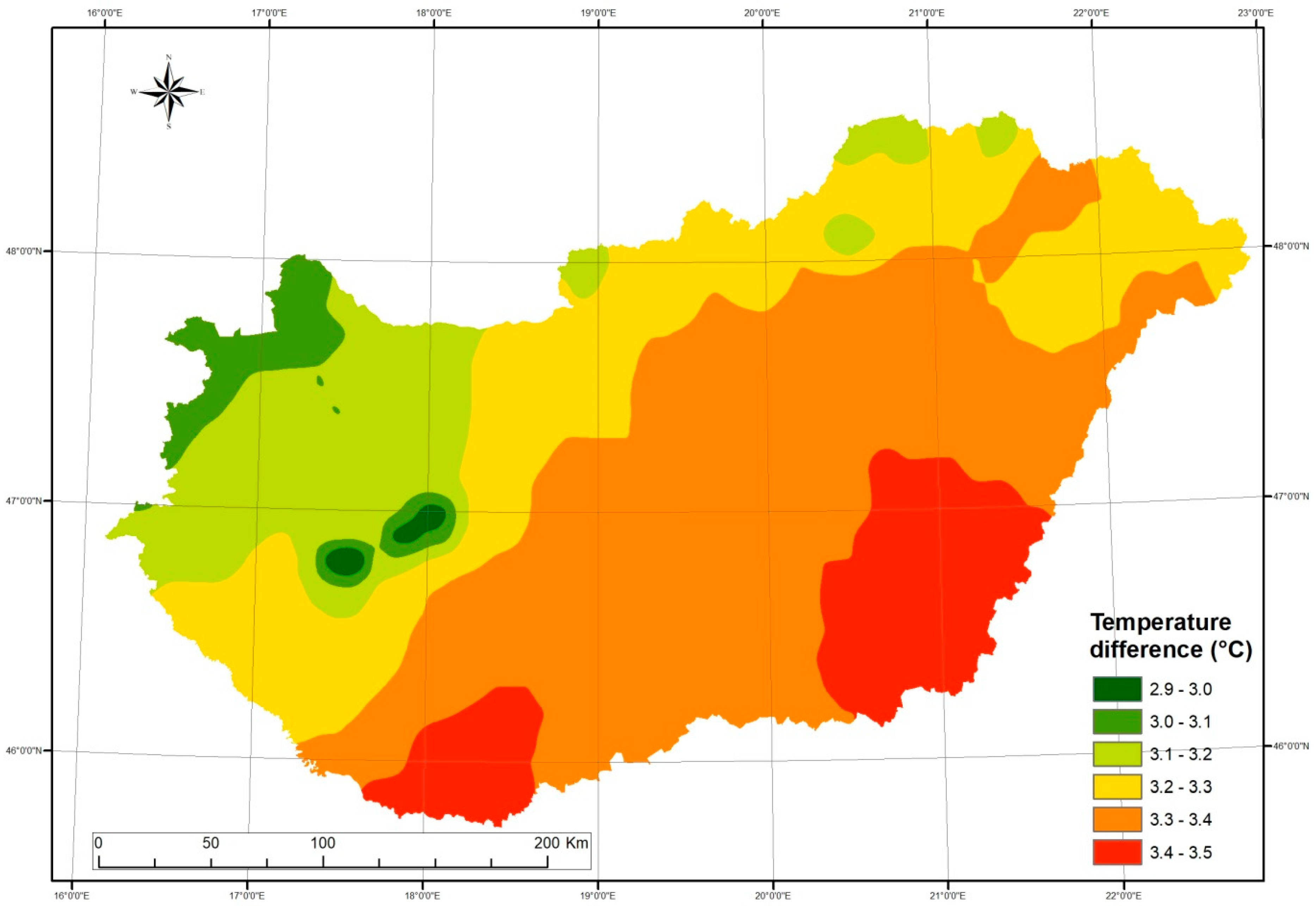
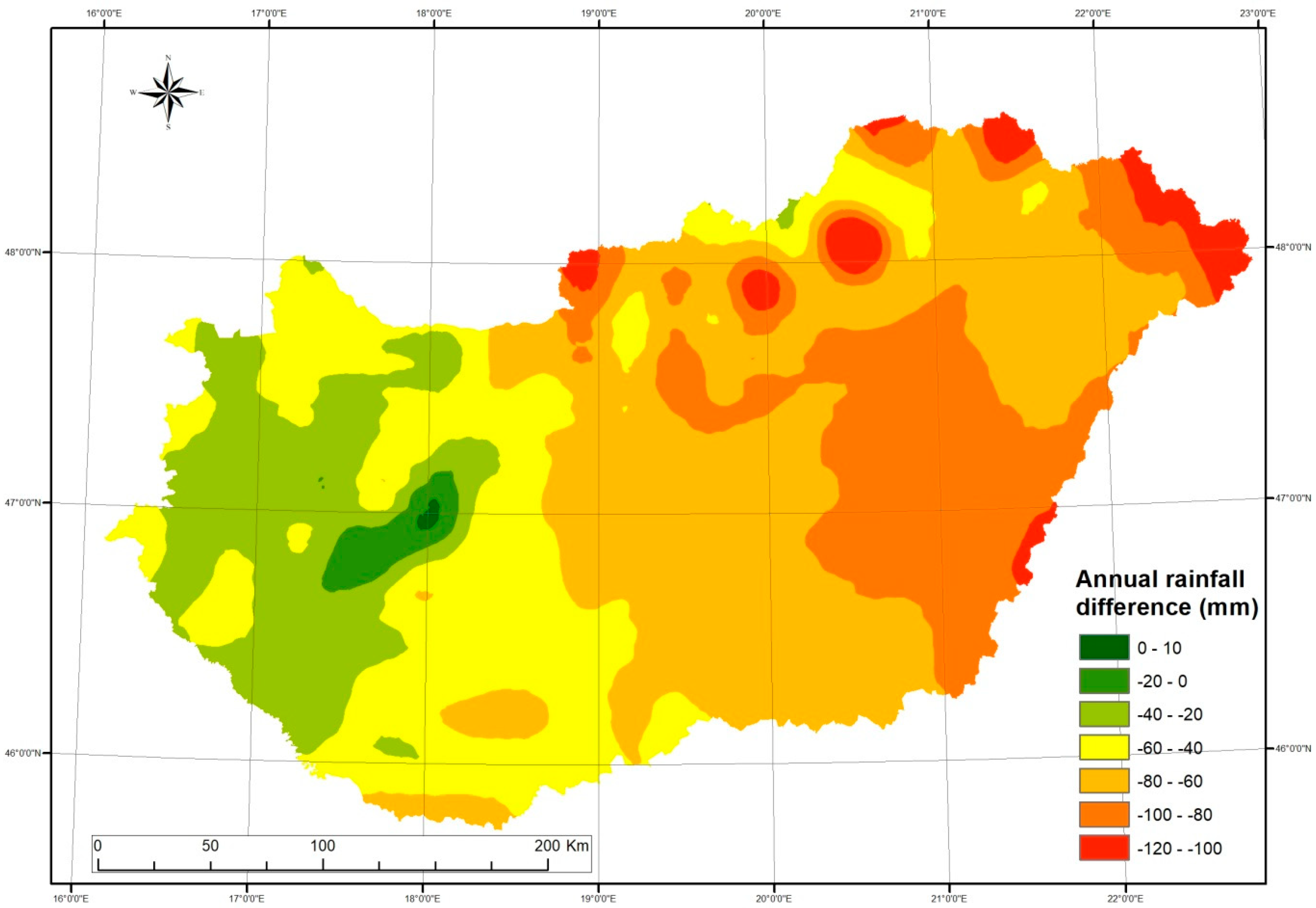
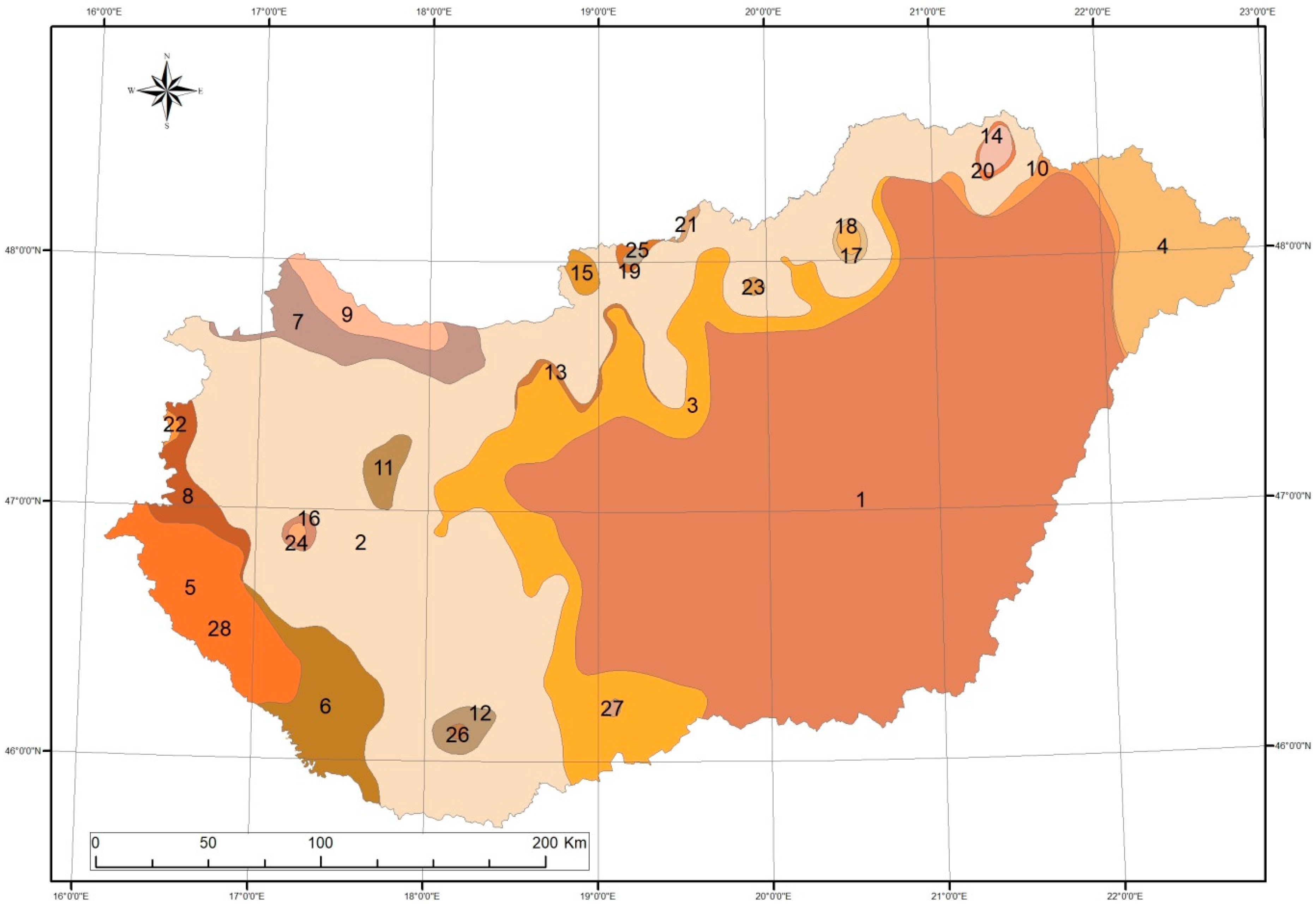
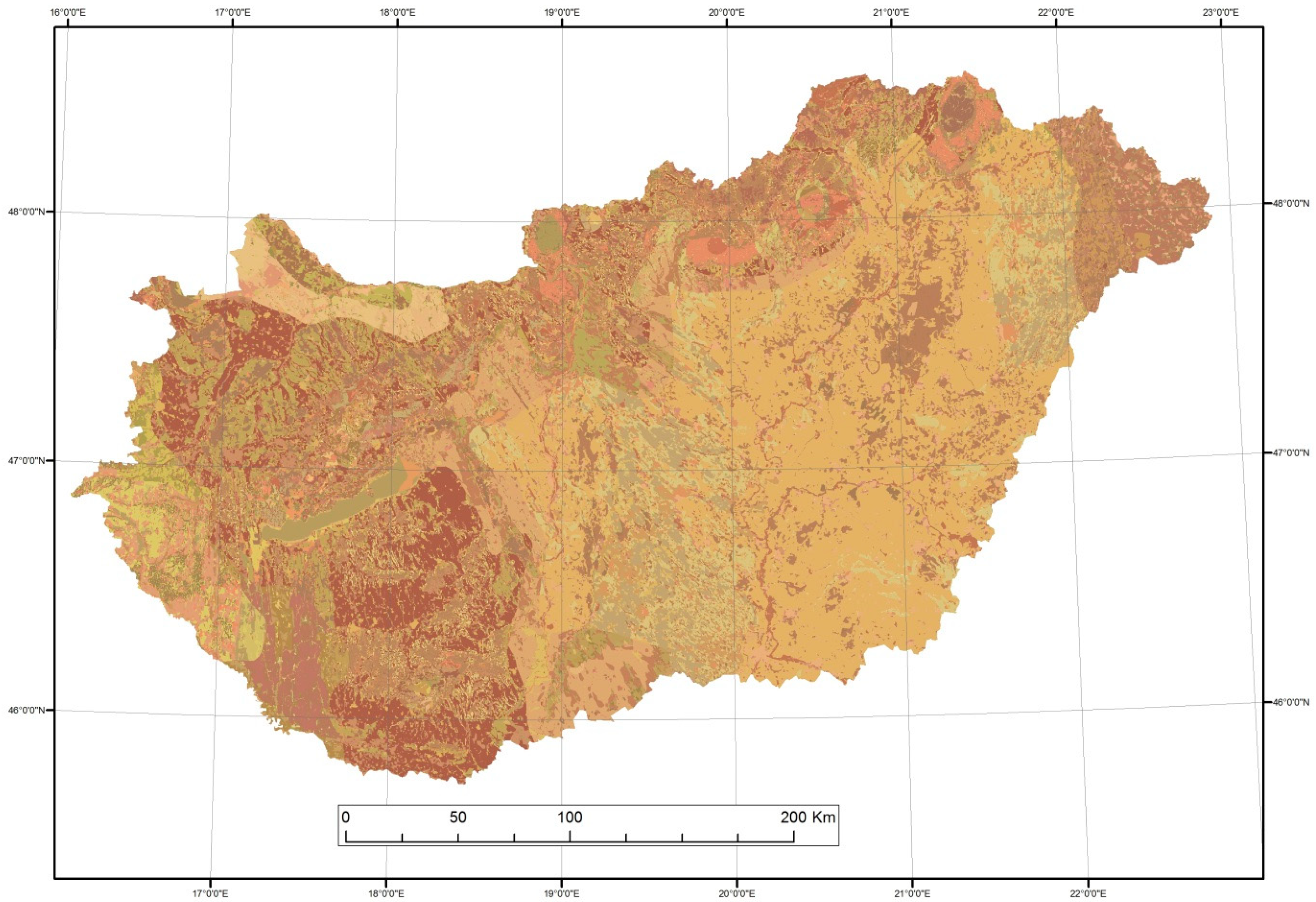
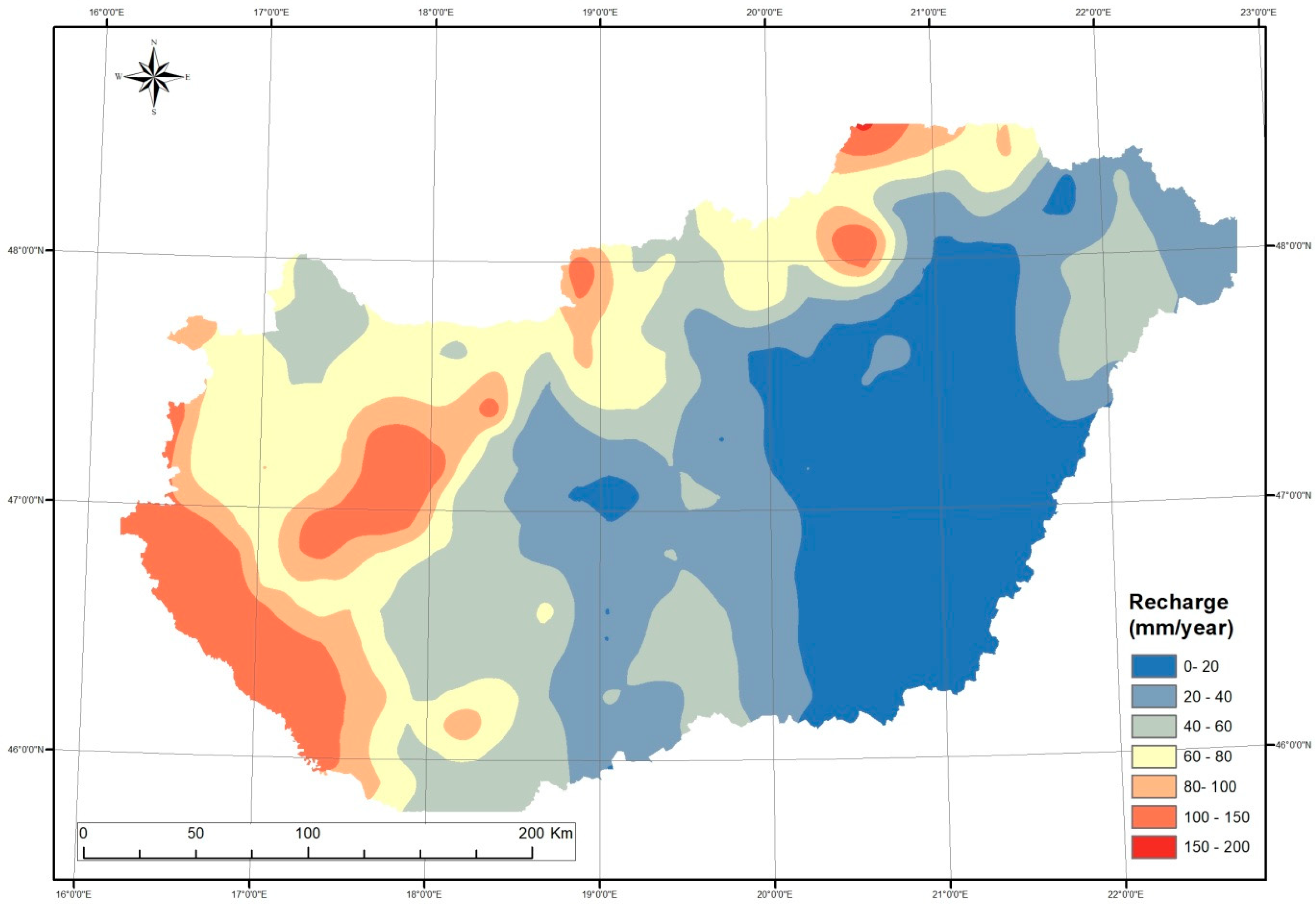
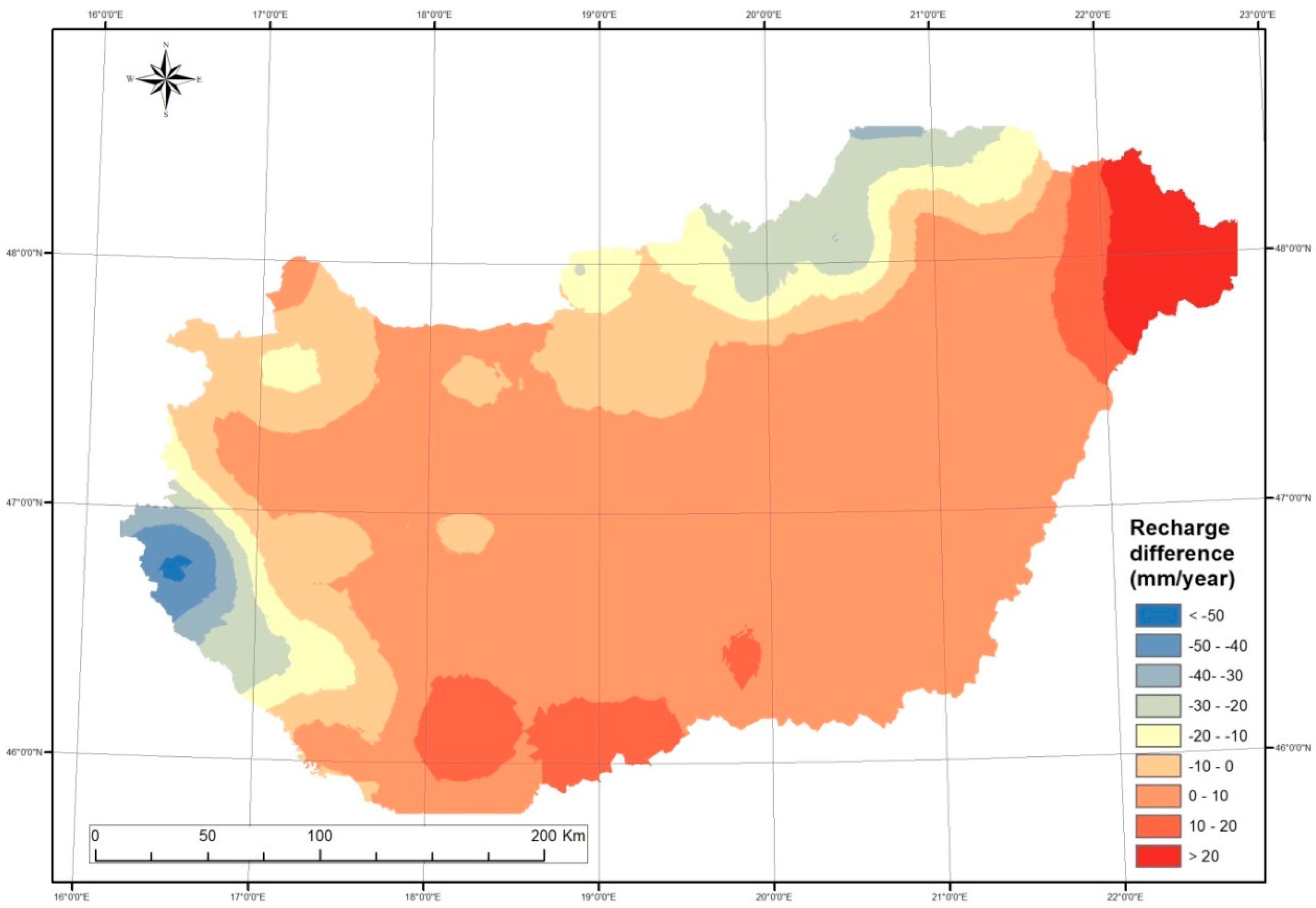
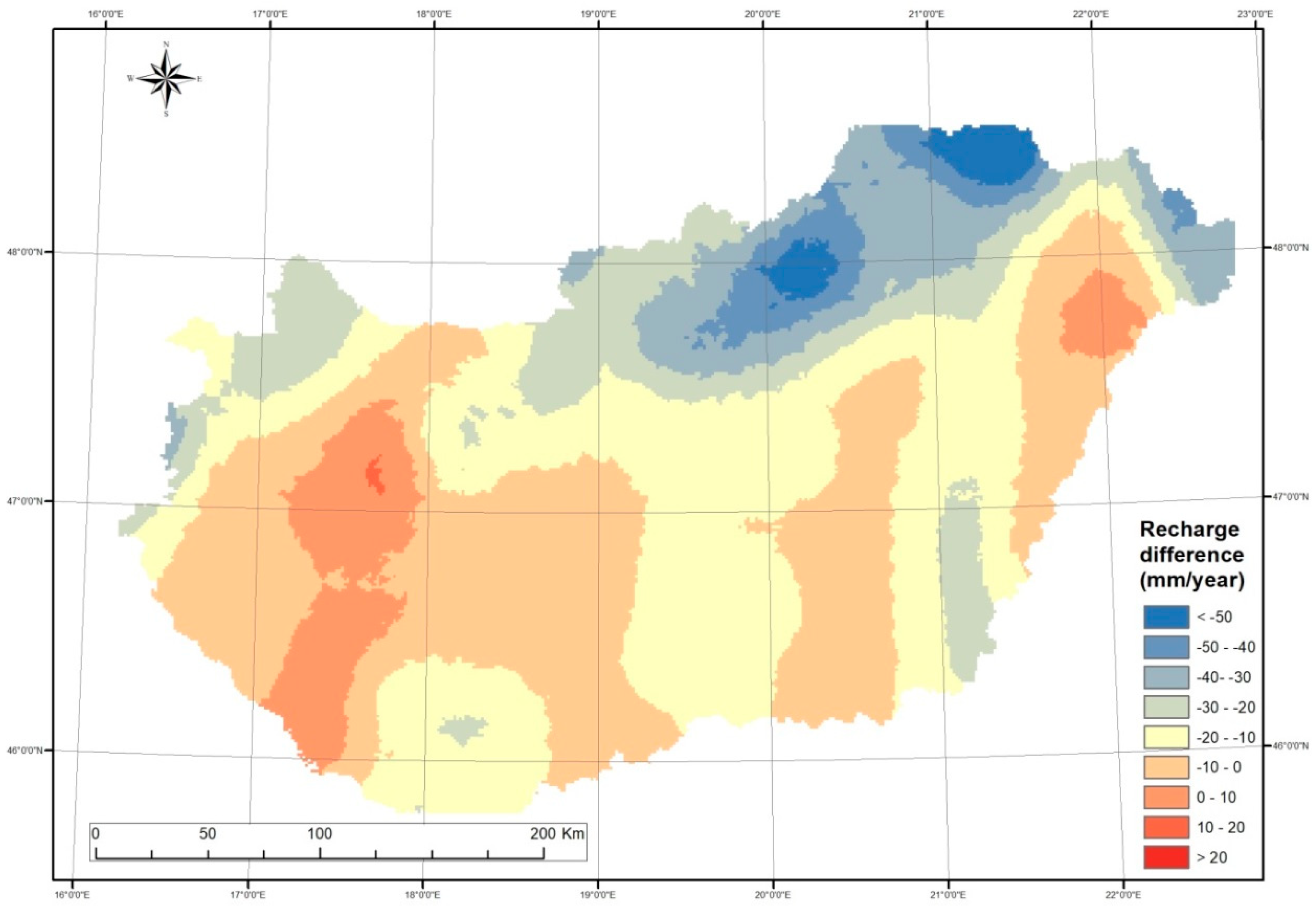
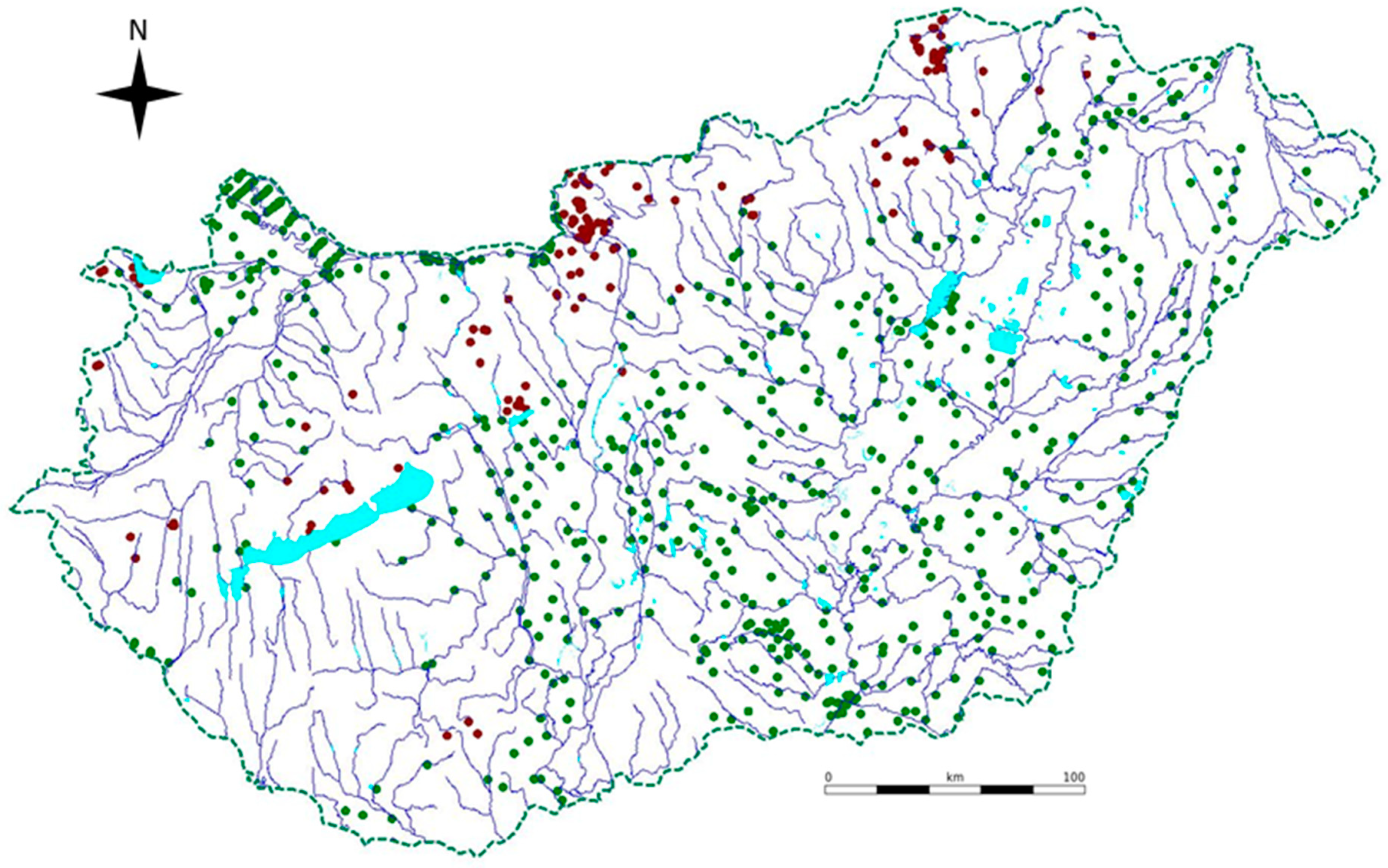

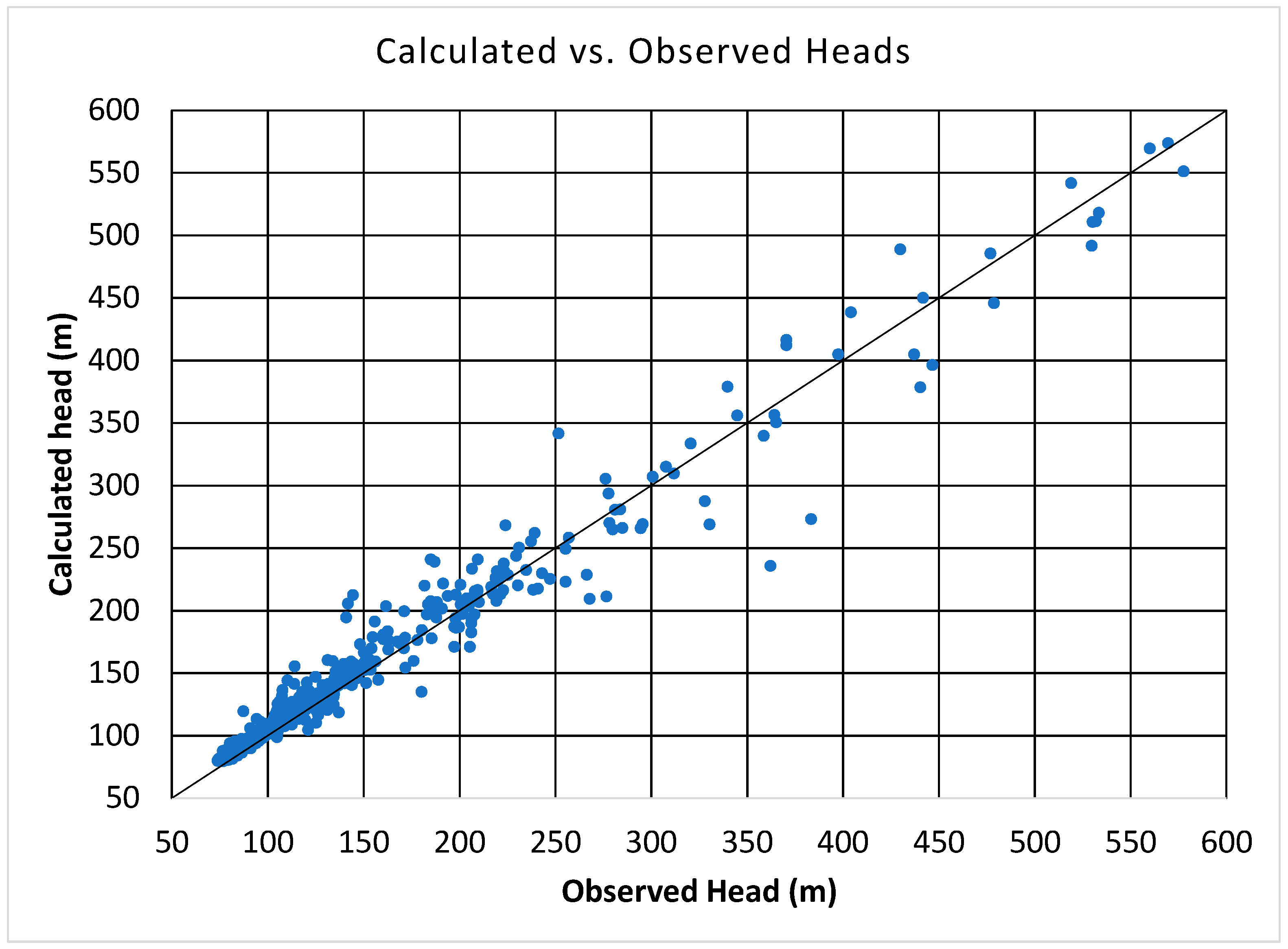
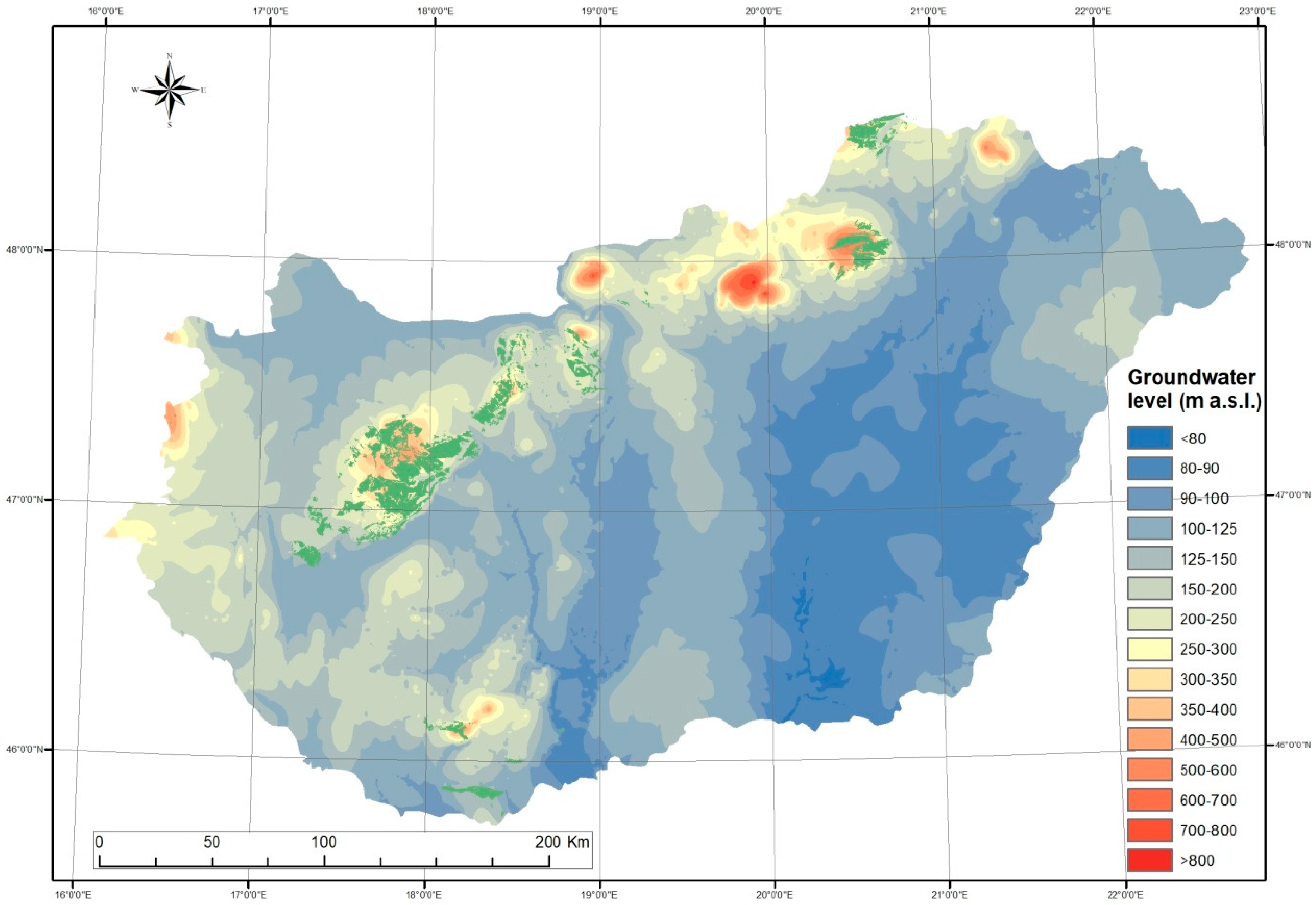
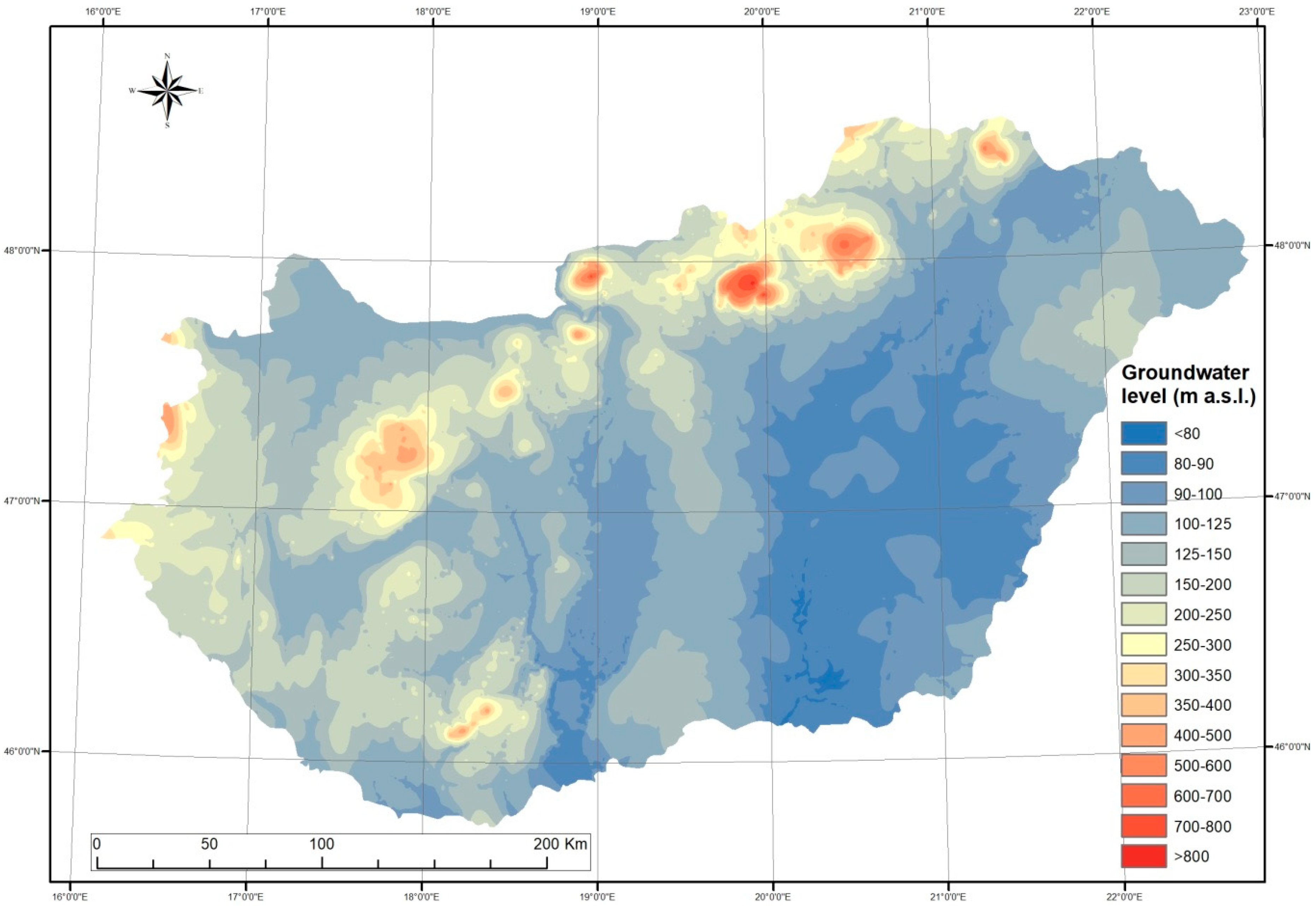
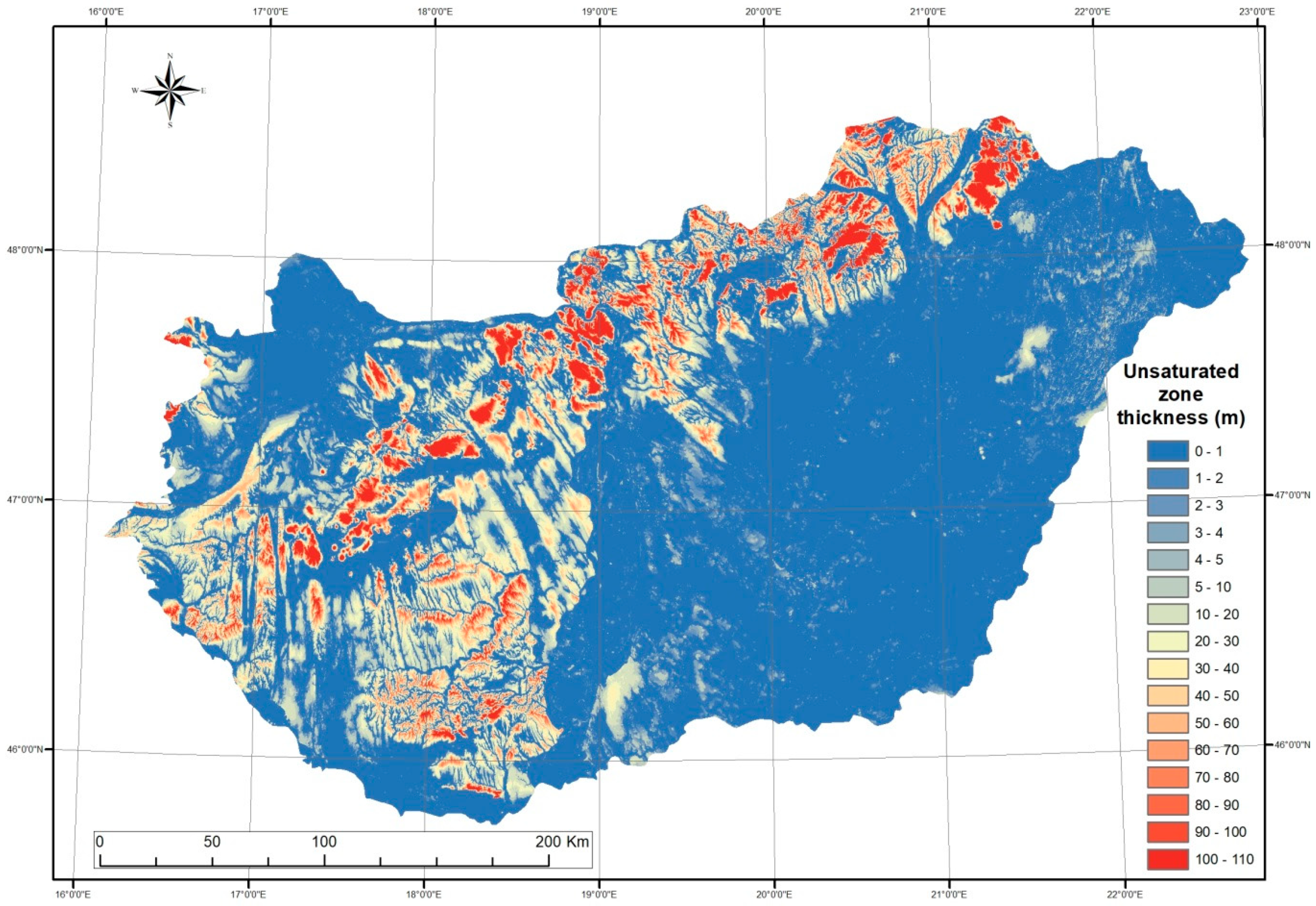
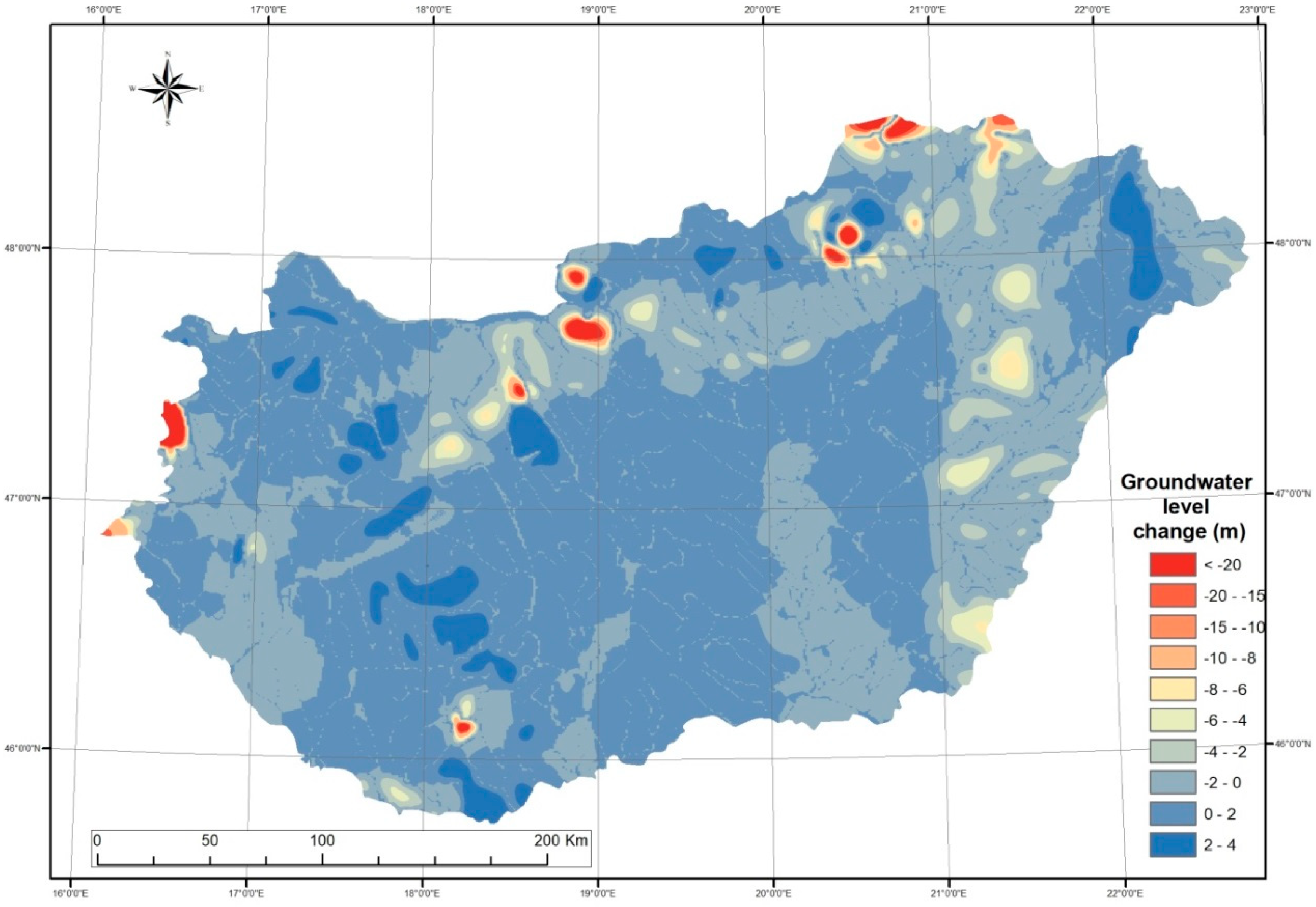
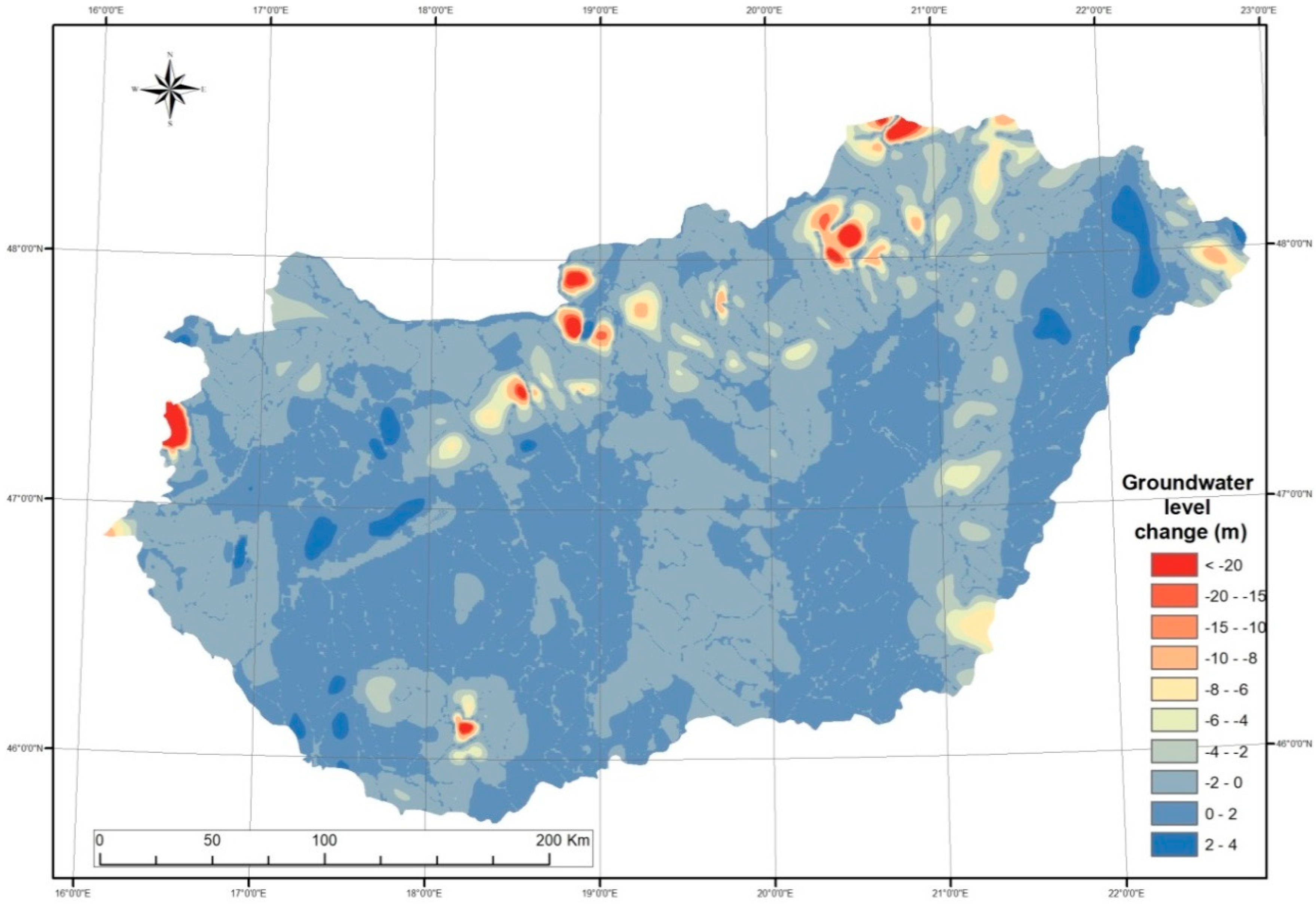
Publisher’s Note: MDPI stays neutral with regard to jurisdictional claims in published maps and institutional affiliations. |
© 2021 by the authors. Licensee MDPI, Basel, Switzerland. This article is an open access article distributed under the terms and conditions of the Creative Commons Attribution (CC BY) license (http://creativecommons.org/licenses/by/4.0/).
Share and Cite
Kovács, A.; Jakab, A. Modelling the Impacts of Climate Change on Shallow Groundwater Conditions in Hungary. Water 2021, 13, 668. https://doi.org/10.3390/w13050668
Kovács A, Jakab A. Modelling the Impacts of Climate Change on Shallow Groundwater Conditions in Hungary. Water. 2021; 13(5):668. https://doi.org/10.3390/w13050668
Chicago/Turabian StyleKovács, Attila, and András Jakab. 2021. "Modelling the Impacts of Climate Change on Shallow Groundwater Conditions in Hungary" Water 13, no. 5: 668. https://doi.org/10.3390/w13050668




